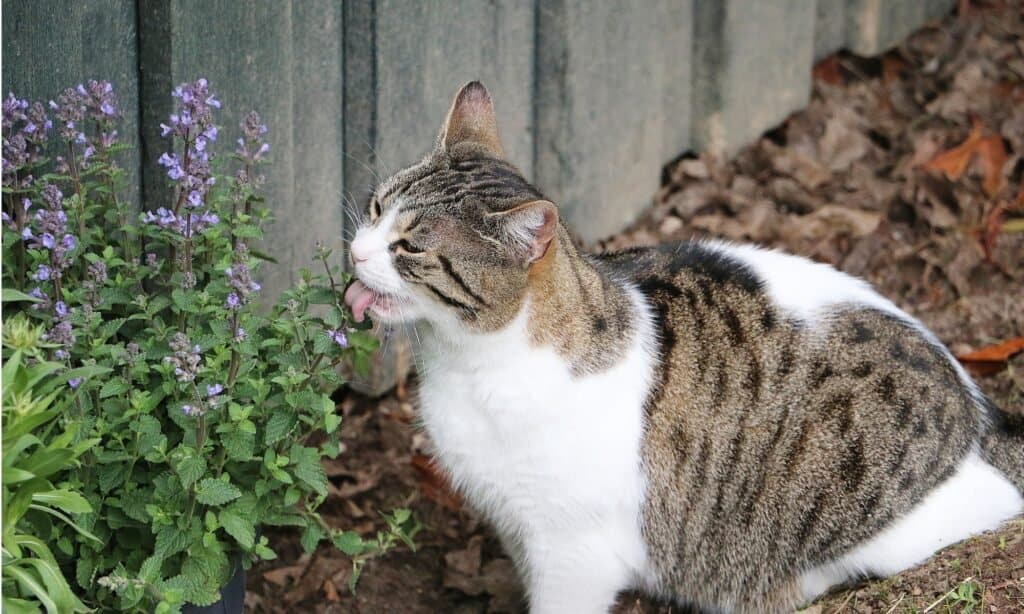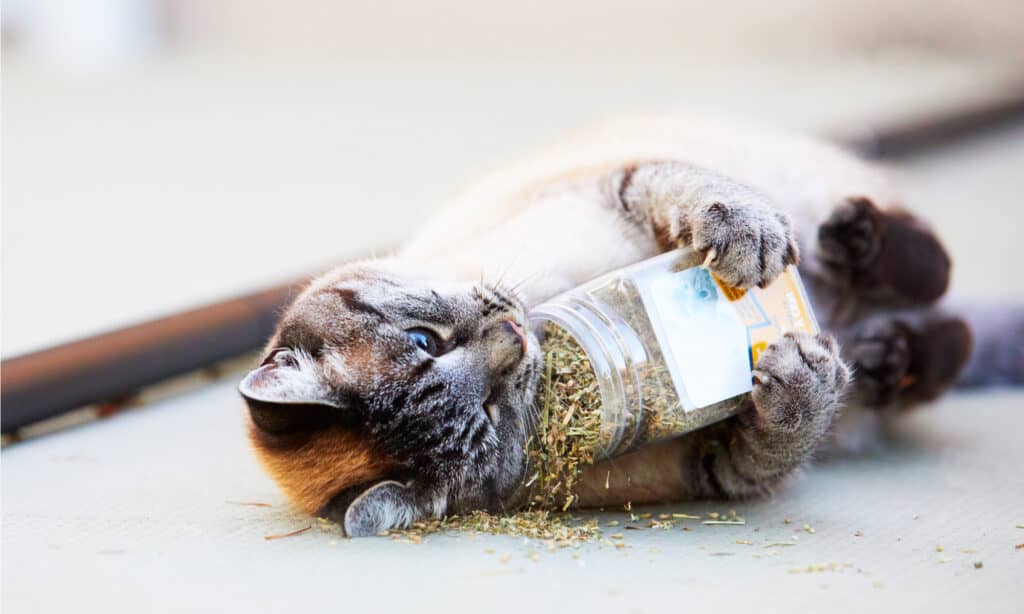Cats have different reactions to catnip. Some stare off into space as if they’re having an existential crisis while others spaz out, tapping their little paws all over the floor and rolling in the catnip as if they just can’t get enough. However, some cats have no reaction at all—researchers estimate that at least 50% of cats are completely unaffected by catnip. Below, we explore what catnip is, how it affects cats, and why they like it. We also explain how to give catnip to your cat and share some other less-known uses for catnip.
What Is Catnip?

The active ingredient in catnip is nepetalactone.
©Attila Fedyk/Shutterstock.com
Catnip is an herb. Its official name is Nepeta cataria and it’s a member of the mint family. It grows easily throughout North America and its appearance includes lavender-colored flowers and light green foliage that resembles the feathers of a bird. The stems are thick and fuzzy. Many people use this herb to make tea. Some people also believe that using the flowers can help to relieve coughs. Catnip has an active ingredient called nepetalactone, which is ultimately what makes your cat go crazy for it. This chemical is produced within the catnip plant, and it can be found coated throughout the seed pods, stems, and leaves. It exists in tiny, microscopic bulbs that when ruptured, release the chemical into the air. If you’ve ever caught your cat chewing away at a catnip plant, that’s exactly what they’re doing. They’re attracted to the chemical and they’re getting the plant to release more of it into the air.
Why Cats Like Catnip
Put simply, cats like this plant because they enjoy how it makes them feel. When your cat likes licking the herb, rolling around in it, or biting the actual leaves of the plant, they release that active ingredient called nepetalactone that puts them into a euphoric state. Cats respond to this active ingredient almost as if it were a pheromone, but scientists are truly still puzzled when it comes to understanding why cats react this way to catnip.
You probably have a few pleasures yourself. Whether it’s a glass of wine at the end of a long day, a bubble bath with fragrant candles, a favorite slice of pie, a delicious cup of coffee to get your morning started, or anything else you can think of that gives you that uplifted feeling—you can equate that with the feelings your cat experiences when they get a taste of catnip.
How Catnip Affects Cats

Cats like catnip because the active ingredient can make them become euphoric or promote other positive states.
©iStock.com/BiancaGrueneberg
The first time you give your cat catnip, whether it’s the actual herb in a small pot or whether it’s dried catnip, you’ll notice that if your cat is one to enjoy catnip, they’ll immediately start trying to release that active ingredient. This could look like chewing on the leaves, pawing at the dried cat nip, or full-on rolling around in it. Once they’ve gotten a taste of the nepetalactone, they’re going to want more.
When they’ve gotten a good catnip high, your cat may display a set of bizarre behaviors. Some cats get super energized and start running about in zoomies or jumping onto their cat tree or other favorite spots. Other cats seem to respond with more of a relaxed feeling, stretching out and staying close to the catnip, maybe still rolling around in it. How catnip affects cats is different depending on the cat so you could experience anything from those two extremes to something more subtle and muted.
How Long the Effects of Catnip Last
The good thing about catnip is that it only lasts about five to 10 minutes. Don’t worry, if your cat does get the zoomies, they’ll calm down after a few minutes. Interestingly, after your cat has experienced the feelings associated with catnip, they temporarily become immune to those same sensations. Therefore, if your cat happens to get into a bag of dry catnip while you’re away from home, they are not going to be totally spazzed out for hours on end. Rather, they’ll have that initial experience of euphoria and then the effects will calm down and they won’t really be able to get another wave of euphoria immediately after.
Other Animals That Respond to Catnip
As you know, not all cats respond to catnip. Typically, it’s the little baby kittens and some older cats that are less likely to experience those feelings of euphoria when you present catnip to them. However, you might wonder, especially if you have other pets at home, if catnip affects other animals. Catnip does seem to affect other animals but only other big cats like lions, tigers, and leopards. Other animals have been tested with catnip like dogs, rabbits, and mice but they have not had a reaction to catnip the way cats do. So, as far as we know, it’s only domesticated cats and wild cats that respond this way to catnip.
How to Give Catnip to Your Cat

Sprinkling a little catnip on the floor, adding it to a toy or giving access to a fresh plant as it grows are some of the best ways to give catnip.
©Pixel Cat Photo/Shutterstock.com
There is a variety of different ways that you can give catnip to your cat. Some cat parents choose catnip toys that already come with a little bit of catnip inside them and usually, they also come with a small bag of loose dried catnip that you can use to refill it once the effects have worn off. These little toys can help your cat enjoy playtime with you or playtime alone pawing away at it. You can typically also pick up those cardboard scratchers where you can place some loose catnip into the ridges so that your cat can enjoy those happy feelings every time they go over to claw at it.
Catnip can also be helpful when transitioning your pet to a new home environment. Placing a little bit of catnip can help to encourage those skittish kitties to become more playful and more comfortable in their new environment. Similarly, you can use catnip to entice your cat to get into a carrier and to keep them entertained during a car ride. You can also just place a little bit on the floor and let your cat explore what it is and how it makes them feel but, of course, you will have to clean up after.
Other Uses for Catnip
Humans have long used catnip for its medicinal effects. Typically, it’s taken as tea to induce a mild state of sedation. This can be a helpful side effect, especially when treating conditions like headache, nausea, and toothaches.
The photo featured at the top of this post is © Anna Hoychuk/Shutterstock.com
FAQs (Frequently Asked Questions)
Why doesn’t my cat like catnip?
A cat’s predisposition to enjoy catnip is hereditary. Ultimately, if your cat doesn’t enjoy catnip, it’s because they don’t have the gene that causes that response. However, this isn’t the only reason your cat may respond to catnip. If you’re trying to introduce catnip to a young kitten, they may just be too young to appreciate the effects. Try again when your cat is a little bit older to see if they take to it then. For older kitties, they may not enjoy catnip the way they used to in their younger adult years. If that is the case for your cat, it’s not an issue. Simply, they won’t enjoy catnip but can make use of other toys and treats!
Can catnip affect humans?
Catnip does have medicinal uses for humans—but humans don’t get a sudden burst of energy the way some cats do. Catnip has primarily been used as a tea that delivers mild sedating effects. It can be helpful for relieving discomforts like pain and nausea and can help to create a calming effect.
Is catnip bad for cats?
No, research doesn’t show that catnip has any negative or harmful effects on cats when provided regularly. However, it’s important that you keep catnip stored in a safe location where your cat can’t get to the whole bag. If a cat ingests too much catnip, it can produce vomiting and diarrhea. It’s best to prevent these potential side effects and keep your cat happy and healthy by only giving catnip when you’re there to supervise.
Thank you for reading! Have some feedback for us? Contact the AZ Animals editorial team.






